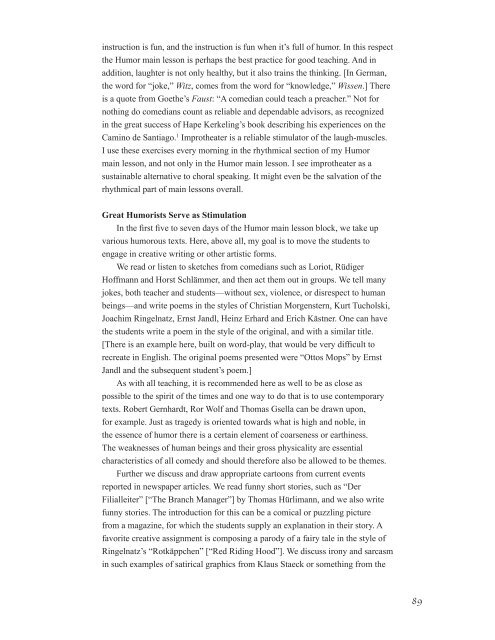Observing the Class Observing the Children - Research Institute for ...
Observing the Class Observing the Children - Research Institute for ...
Observing the Class Observing the Children - Research Institute for ...
You also want an ePaper? Increase the reach of your titles
YUMPU automatically turns print PDFs into web optimized ePapers that Google loves.
instruction is fun, and <strong>the</strong> instruction is fun when it’s full of humor. In this respect<br />
<strong>the</strong> Humor main lesson is perhaps <strong>the</strong> best practice <strong>for</strong> good teaching. And in<br />
addition, laughter is not only healthy, but it also trains <strong>the</strong> thinking. [In German,<br />
<strong>the</strong> word <strong>for</strong> “joke,” Witz, comes from <strong>the</strong> word <strong>for</strong> “knowledge,” Wissen.] There<br />
is a quote from Goe<strong>the</strong>’s Faust: “A comedian could teach a preacher.” Not <strong>for</strong><br />
nothing do comedians count as reliable and dependable advisors, as recognized<br />
in <strong>the</strong> great success of Hape Kerkeling’s book describing his experiences on <strong>the</strong><br />
Camino de Santiago. 1 Impro<strong>the</strong>ater is a reliable stimulator of <strong>the</strong> laugh-muscles.<br />
I use <strong>the</strong>se exercises every morning in <strong>the</strong> rhythmical section of my Humor<br />
main lesson, and not only in <strong>the</strong> Humor main lesson. I see impro<strong>the</strong>ater as a<br />
sustainable alternative to choral speaking. It might even be <strong>the</strong> salvation of <strong>the</strong><br />
rhythmical part of main lessons overall.<br />
Great Humorists Serve as Stimulation<br />
In <strong>the</strong> first five to seven days of <strong>the</strong> Humor main lesson block, we take up<br />
various humorous texts. Here, above all, my goal is to move <strong>the</strong> students to<br />
engage in creative writing or o<strong>the</strong>r artistic <strong>for</strong>ms.<br />
We read or listen to sketches from comedians such as Loriot, Rüdiger<br />
Hoffmann and Horst Schlämmer, and <strong>the</strong>n act <strong>the</strong>m out in groups. We tell many<br />
jokes, both teacher and students—without sex, violence, or disrespect to human<br />
beings—and write poems in <strong>the</strong> styles of Christian Morgenstern, Kurt Tucholski,<br />
Joachim Ringelnatz, Ernst Jandl, Heinz Erhard and Erich Kästner. One can have<br />
<strong>the</strong> students write a poem in <strong>the</strong> style of <strong>the</strong> original, and with a similar title.<br />
[There is an example here, built on word-play, that would be very difficult to<br />
recreate in English. The original poems presented were “Ottos Mops” by Ernst<br />
Jandl and <strong>the</strong> subsequent student’s poem.]<br />
As with all teaching, it is recommended here as well to be as close as<br />
possible to <strong>the</strong> spirit of <strong>the</strong> times and one way to do that is to use contemporary<br />
texts. Robert Gernhardt, Ror Wolf and Thomas Gsella can be drawn upon,<br />
<strong>for</strong> example. Just as tragedy is oriented towards what is high and noble, in<br />
<strong>the</strong> essence of humor <strong>the</strong>re is a certain element of coarseness or earthiness.<br />
The weaknesses of human beings and <strong>the</strong>ir gross physicality are essential<br />
characteristics of all comedy and should <strong>the</strong>re<strong>for</strong>e also be allowed to be <strong>the</strong>mes.<br />
Fur<strong>the</strong>r we discuss and draw appropriate cartoons from current events<br />
reported in newspaper articles. We read funny short stories, such as “Der<br />
Filialleiter” [“The Branch Manager”] by Thomas Hürlimann, and we also write<br />
funny stories. The introduction <strong>for</strong> this can be a comical or puzzling picture<br />
from a magazine, <strong>for</strong> which <strong>the</strong> students supply an explanation in <strong>the</strong>ir story. A<br />
favorite creative assignment is composing a parody of a fairy tale in <strong>the</strong> style of<br />
Ringelnatz’s “Rotkäppchen” [“Red Riding Hood”]. We discuss irony and sarcasm<br />
in such examples of satirical graphics from Klaus Staeck or something from <strong>the</strong><br />
89

















